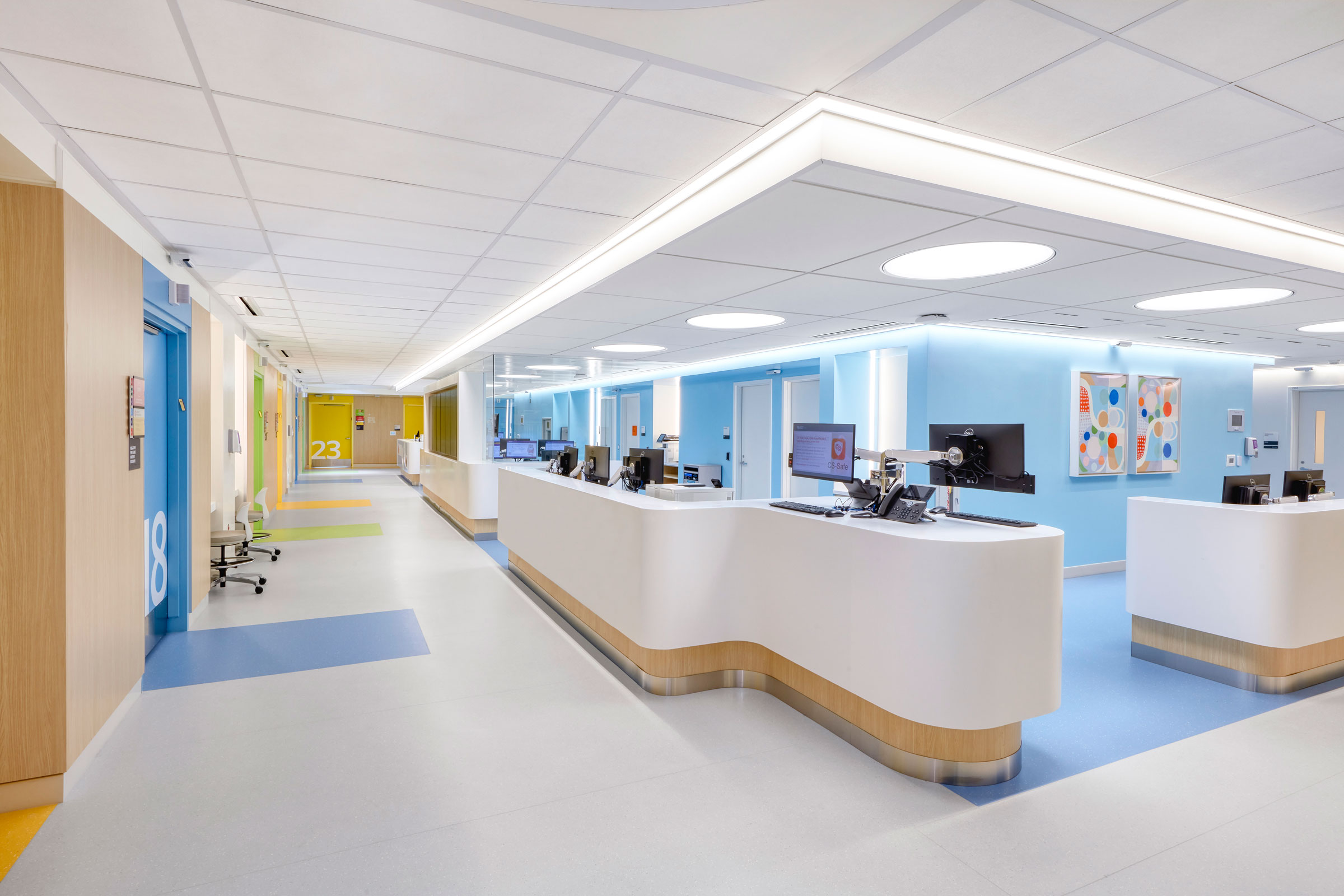Story at a glance:
- The strain of the pandemic exposed structural issues in health care design.
- Adequate flooring plays a crucial role in the evolution of health care design at facilities like Cedars-Sinai.
- Health care flooring from Roppe is flexible in design, seamless, aesthetic, and low maintenance.
Gone are the days of cold and sterile health care spaces with little to no natural light. In this new era of health care design, facilities like Cedars-Sinai Medical Center in Los Angeles prioritize beautiful and comfortable spaces just as much as quality patient service.
In fact, patient satisfaction and the positive attributes of a health care space often correlate.
“We try to enhance spaces where patients spend the majority of their time and elevate them in a way that provides positive distractions and create a sense of comfort and warmth,” says Kelly Redrico, manager of interior design, facilities planning, design and construction for Cedars-Sinai.
This goal remains crucial—especially in recent years. The Covid pandemic presented many challenges to health care providers and patients while also exposing the structural issues that existed prior to the crisis. Burnout and labor shortages became more prevalent, supply chain problems persist, and the rise of telehealth has challenged the need for in-person care.
Workers quit their jobs at a rate of nearly 4 million per month in 2021, according to the US Bureau of Labor Statistics. These “Great Resignation” numbers grew to 4.5 million quitting in March 2022. An additional 4.4 million quit in April of that year. The health care industry lost more than 500,000 employees per month, in large part due to the stress of the pandemic.
How Designers are Rethinking Spaces
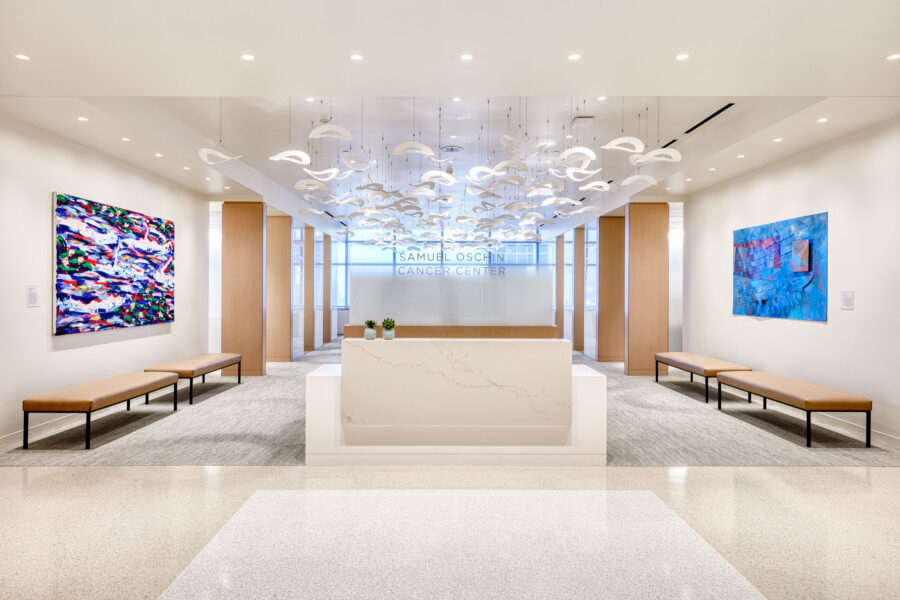
Warm light and colorful art fill the Samuel Oschin Cancer Center at Cedars-Sinai. Photo courtesy of Cedars-Sinai
In an effort to foster wellness and improve well-being, health care designers have strived to put more emphasis on indoor air quality, natural light, and staff and patient safety.
“We tend to bring in more natural light to our interior environment whether through planning key areas along the perimeter of the buildings or getting more window views,” Redrico says. “We do have spaces like basements, and it’s just sometimes impossible to bring in natural light, so we try to bring in lighting that emulates natural daylight.”
Building for the future is building for flexibility, so we bring in things that can be easily maintained and changed.
With so much uncertainty about the future, experts say it’s critical that health care design be timeless and adaptable. Redrico has seen an increased use of more robust materials in her 14 years at Cedars-Sinai. And with the help of new technology, designers have been able to enhance spaces with high-performance solutions across areas like flooring and lighting.
Cedars-Sinai uses neutral colors combined with accents to create lasting spaces with just the right amount of simplicity and elegance. “In the past we planned and designed for the present. Now it’s all about, ‘Let’s build for the future.’ But the future is sometimes unknown,” Redrico says. “Building for the future is building for flexibility, so we bring in things that can be easily maintained and changed.”
Flooring in Health Care
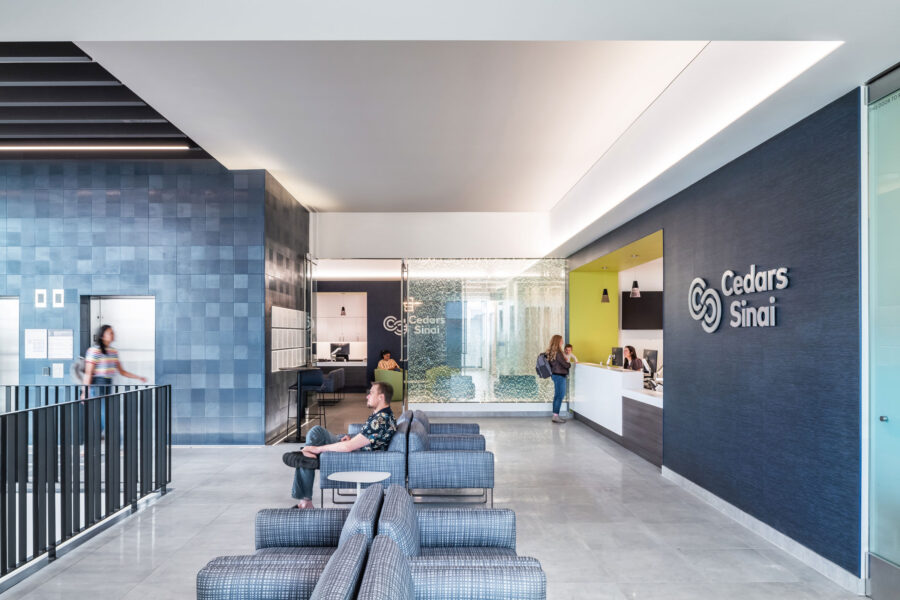
A new urgent care facility in Los Feliz incorporates the colors and feel of the neighborhood where it’s located. Photo courtesy of Abramson Architects
Color schemes aside, flooring plays a crucial role in the evolution of health care design at Cedars-Sinai and beyond. Health care designers have particularly gravitated toward rubber flooring, for example.
Rubber health care flooring offers an inherent slip resistance that other products cannot replicate. In addition to offering under-foot comfort that reduces fatigue for patients, visitors, and health care professionals, the flooring is also durable, as it’s designed for rigorous daily wear and tear. “Patient units or high-traffic areas like corridors must be durable with long-lasting materials to avoid constant replacement,” Redrico says.
Designers at Cedars-Sinai apply rubber flooring when they can because it’s more sustainable, lasts longer, and is easy to maintain. “We’ve used rubber in the past and believe it or not, decades later, it’s still there,” Redrico says. “But in the past it wasn’t as aesthetically pleasing, whereas now you have more options.”
Over time rubber flooring manufacturers like Roppe—an Ohio-based commercial rubber and vinyl flooring manufacturer—have added more styles to choose from, too. Manufacturers like Roppe are helping to satisfy a growing demand for adequate, beautiful flooring in health care spaces all over the country. Numerous product lines promote cleanliness and safety while also being low-maintenance, stain-resistant, and oppose fungal growth.
Examples of Today’s Flooring Products
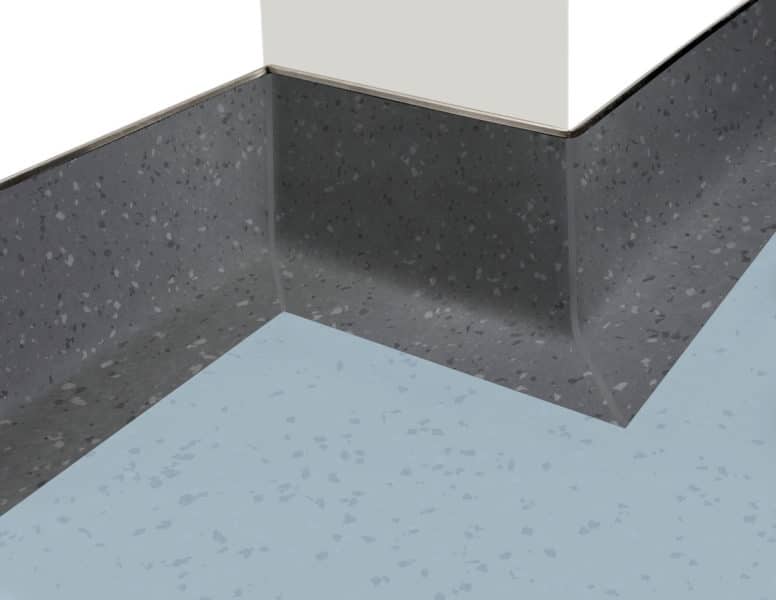
Closeup of FlashCove installation in Charcoal and Peaceful Blue. Photo courtesy of Roppe
Specifically designed at six feet versus competitors’ typically four-feet wide solutions, Roppe’s Envire Rubber Sheet offers a solution for more seamless installation for patient rooms and corridors, according to Deanna Brickner, marketing manager for Roppe Corporation.
Bricker says competitive products offer options typically two or three millimeters, but Roppe roll lengths measure at 50 feet with a thickness of .100 inches or 2.5 millimeters. “When we were investigating the development of the Envire Rubber Sheet product, we saw there was a need for more seamless installation opportunities,” she says. “Products that could meet that need would need to be wider.”
Envire is available in a 32-color palette with stylish, future-forward tonal chip combinations to support neutral spaces and those where a dash of color is well-suited. “It’s great for patient rooms and especially corridors. A standard 8-foot corridor would allow you to have that six-foot piece in the middle with one foot on each side as a FlashCove,” Brickner says. “That way you’re not walking on that seam.”
The FlashCove prefabricated bases are puncture- proof and immune to the challenges that site form bases are susceptible to, Brickner says. Bonded puncture-proof aluminum reinforcement offers high-performance against maintenance machines and point loads like chairs.
Brickner says a more seamless installation also means less places for germs and moisture to hide. “That is definitely a positive.” More benefits of health care flooring solutions like these include:
Sustainability
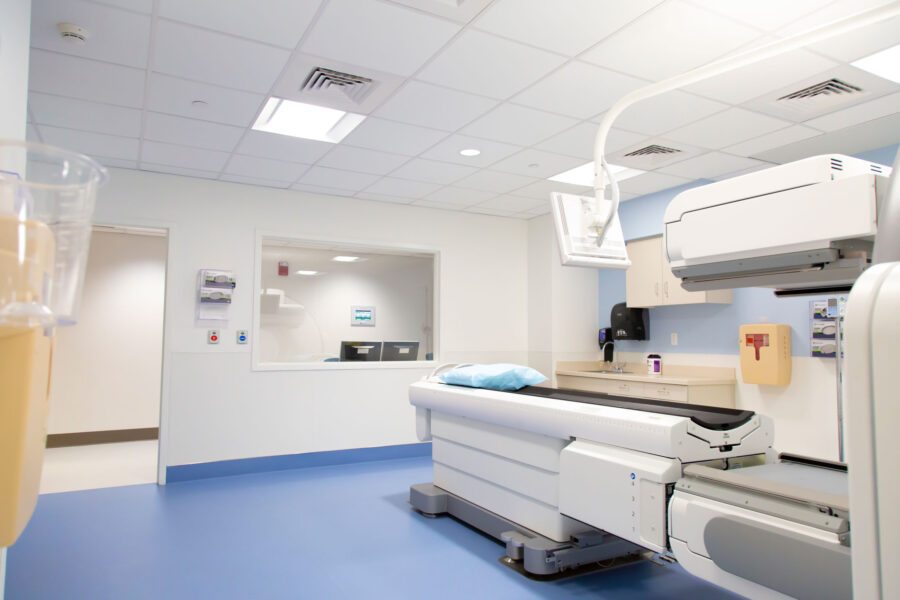
The Tufts Medical Center in Boston uses the Envire Rubber Sheet in Bluebell and Snow. Photo courtesy of Roppe
Roppe’s rubber flooring is made in the US with many third-party certifications. It’s Red List–free and meets FloorScore and Greenguard Gold criteria. Select rubber flooring is also USDA BioPreferred, meaning it uses a percentage of bio-based materials.
Brickner says efficient and economic cleaning and maintenance solutions also don’t require the application of chemical finishes, helping facilities and operational systems and their budgets. Simply buffing the rubber flooring lessens the use of strippers, polishes, or other harmful cleaning chemicals.
Aesthetics
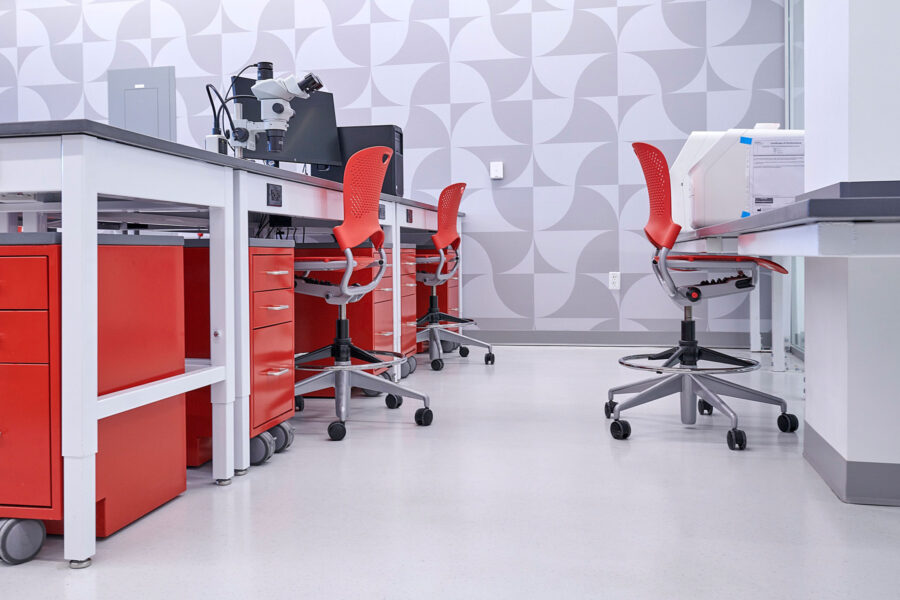
The Envire Rubber Sheet is seen here in the color snow at a biochemistry and molecular biology space in Boston. Photo courtesy of Roppe
Roppe also offers a plethora of rubber and vinyl flooring solutions that can stand alone or be combined for effective health care designs.
“Different flooring may be required for general population spaces versus operating rooms, patient rooms, laboratory spaces, or flooring you might use in a rehabilitation area,” Brickner says. “All of those things need to be taken into consideration, but the spaces can all be functional and appealing.”
Choosing flooring that supports that desired emotion of the space while functioning appropriately is always the goal.
Experts say vibrant spaces create feelings of joy and inspiration in patients while neutral shades encourage relaxation, calmness, and comfort as they heal. “Color plays a very large role in space design, especially for health care,” Brickner says. “Choosing flooring that supports that desired emotion of the space while functioning appropriately is always the goal.”
Roppe offers more than 200 colorways within its rubber lines—including solid, marble, tonal chip, and contrasting chip, along with a cork-infused option that allows for integrated design while using visually appealing selections. Roppe’s vinyl flooring works with several of the most popular hues.
“We have looked at our overall product offering—all of our rubber and vinyl flooring options—and we realigned those so we have a lot more consistent colorways running through all of the products,” Brickner says.
Roppe offers 70 colors in its refreshed solid rubber palette—29 of which are new and available in rubber tile, rubber tread, wall base, and accessories. The refreshed color palette includes expanded neutrals with subtle variation for broad appeal, complementary vibrant colors for focal emphasis, and enhanced overall depth of color, including broad ranges within the hues.

